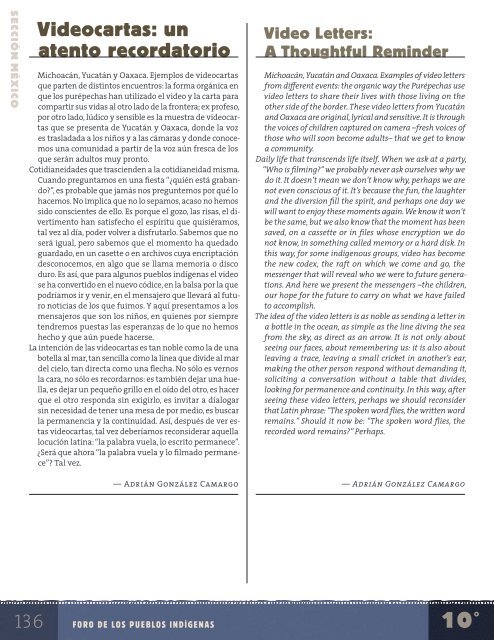catalogo-2012
catalogo-2012
catalogo-2012
Create successful ePaper yourself
Turn your PDF publications into a flip-book with our unique Google optimized e-Paper software.
SECCIÓN MÉXICO<br />
Videocartas: un<br />
atento recordatorio<br />
Michoacán, Yucatán y Oaxaca. Ejemplos de videocartas<br />
que parten de distintos encuentros: la forma orgánica en<br />
que los purépechas han utilizado el video y la carta para<br />
compartir sus vidas al otro lado de la frontera; ex profeso,<br />
por otro lado, lúdico y sensible es la muestra de videocartas<br />
que se presenta de Yucatán y Oaxaca, donde la voz<br />
es trasladada a los niños y a las cámaras y donde conocemos<br />
una comunidad a partir de la voz aún fresca de los<br />
que serán adultos muy pronto.<br />
Cotidianeidades que trascienden a la cotidianeidad misma.<br />
Cuando preguntamos en una fiesta “¿quién está grabando?”,<br />
es probable que jamás nos preguntemos por qué lo<br />
hacemos. No implica que no lo sepamos, acaso no hemos<br />
sido conscientes de ello. Es porque el gozo, las risas, el divertimento<br />
han satisfecho el espíritu que quisiéramos,<br />
tal vez al día, poder volver a disfrutarlo. Sabemos que no<br />
será igual, pero sabemos que el momento ha quedado<br />
guardado, en un casette o en archivos cuya encriptación<br />
desconocemos, en algo que se llama memoria o disco<br />
duro. Es así, que para algunos pueblos indígenas el video<br />
se ha convertido en el nuevo códice, en la balsa por la que<br />
podríamos ir y venir, en el mensajero que llevará al futuro<br />
noticias de los que fuimos. Y aquí presentamos a los<br />
mensajeros que son los niños, en quienes por siempre<br />
tendremos puestas las esperanzas de lo que no hemos<br />
hecho y que aún puede hacerse.<br />
La intención de las videocartas es tan noble como la de una<br />
botella al mar, tan sencilla como la línea que divide al mar<br />
del cielo, tan directa como una flecha. No sólo es vernos<br />
la cara, no sólo es recordarnos: es también dejar una huella,<br />
es dejar un pequeño grillo en el oído del otro, es hacer<br />
que el otro responda sin exigirlo, es invitar a dialogar<br />
sin necesidad de tener una mesa de por medio, es buscar<br />
la permanencia y la continuidad. Así, después de ver estas<br />
videocartas, tal vez deberíamos reconsiderar aquella<br />
locución latina: “la palabra vuela, lo escrito permanece”.<br />
¿Será que ahora “la palabra vuela y lo filmado permanece”?<br />
Tal vez.<br />
— Adrián González Camargo<br />
136 FORO DE LOS PUEBLOS INDÍGENAS<br />
Video Letters:<br />
A Thoughtful Reminder<br />
Michoacán, Yucatán and Oaxaca. Examples of video letters<br />
from different events: the organic way the Purépechas use<br />
video letters to share their lives with those living on the<br />
other side of the border. These video letters from Yucatán<br />
and Oaxaca are original, lyrical and sensitive. It is through<br />
the voices of children captured on camera –fresh voices of<br />
those who will soon become adults– that we get to know<br />
a community.<br />
Daily life that transcends life itself. When we ask at a party,<br />
“Who is filming?” we probably never ask ourselves why we<br />
do it. It doesn’t mean we don’t know why, perhaps we are<br />
not even conscious of it. It’s because the fun, the laughter<br />
and the diversion fill the spirit, and perhaps one day we<br />
will want to enjoy these moments again. We know it won’t<br />
be the same, but we also know that the moment has been<br />
saved, on a cassette or in files whose encryption we do<br />
not know, in something called memory or a hard disk. In<br />
this way, for some indigenous groups, video has become<br />
the new codex, the raft on which we come and go, the<br />
messenger that will reveal who we were to future generations.<br />
And here we present the messengers –the children,<br />
our hope for the future to carry on what we have failed<br />
to accomplish.<br />
The idea of the video letters is as noble as sending a letter in<br />
a bottle in the ocean, as simple as the line diving the sea<br />
from the sky, as direct as an arrow. It is not only about<br />
seeing our faces, about remembering us: it is also about<br />
leaving a trace, leaving a small cricket in another’s ear,<br />
making the other person respond without demanding it,<br />
soliciting a conversation without a table that divides,<br />
looking for permanence and continuity. In this way, after<br />
seeing these video letters, perhaps we should reconsider<br />
that Latin phrase: “The spoken word flies, the written word<br />
remains.” Should it now be: “The spoken word flies, the<br />
recorded word remains?” Perhaps.<br />
— Adrián González Camargo<br />
10°


